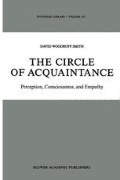Abstract
We are aware of other persons in many different ways. Our thoughts, feelings, or experiences may present another by image in a mental picture, by name as “Dagfinn Føllesdal” or “Virginia Woolf”, by description as “the founder of cubism” or “the leader of the Cuban Revolution”, or indexically as “you” or “she” or “he” or “they”. But it is only in perception, especially in seeing “you” or “her” or “him”, that we are acquainted with other persons.
Access this chapter
Tax calculation will be finalised at checkout
Purchases are for personal use only
Preview
Unable to display preview. Download preview PDF.
Notes
An overall study of Dilthey’s thought is Michael Ermarth 1979], Wilhelm Dilthey: The Critique of Historical Reason.
See Kohut [1971], The Analysis of the Self,
Kohut [1977], The Restoration of the Self,
Kohut [1984], How Does Analysis Cure?
Kohut reports Freud’s attitude toward empathy (at one time in one article at least) in Kohut [1977], p. 306n. Kohut’s definition of empathy as vicarious introspection (again cited in [1977], p. 306) originally occurred in Kohut, “Introspection, Empathy, and Psychoanalysis”, Journal of American Psychoanalytic Association, 7: 459–483, 1959.
A variation on a scene from Sartre. Cf. Sartre [1943], Being and Nothingness, Part Three, Ch. One, IV, “The Look”, pp. 347–348.
See note 3 above on Kohut’s account of the role of empathy in psychoanalysis and in early psychic development. Bruno Bettelheim has argued in [1983], Freud and Man’s Soul, that Freud’s original German prose has a humanistic — and I would say empathic — element that is systematically excised in the standard English translations. In particular, “ich”, “es”, and “überich” have a very different ring to the turn-of-the-century Viennese ear than “ego”, “id”, and “superego” (their standard translations) have for the English or American ear. Of course, I would add, the indexical words “I”, “you”, “her”, and “him” ring with empathy.
See Husserl [1931], Cartesian Meditations, Fifth Meditation, §§49–54, esp. pp. 115–116.
Author information
Authors and Affiliations
Rights and permissions
Copyright information
© 1989 Kluwer Academic Publishers
About this chapter
Cite this chapter
Smith, D.W. (1989). Empathy and Other-Awareness. In: The Circle of Acquaintance. Synthese Library, vol 205. Springer, Dordrecht. https://doi.org/10.1007/978-94-009-0961-8_4
Download citation
DOI: https://doi.org/10.1007/978-94-009-0961-8_4
Publisher Name: Springer, Dordrecht
Print ISBN: 978-94-010-6922-9
Online ISBN: 978-94-009-0961-8
eBook Packages: Springer Book Archive

